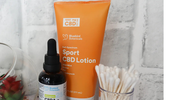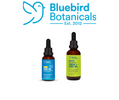What is CBDA? The CBD Precursor You Might Be Missing
In the world of hemp-derived wellness, CBD often steals the spotlight. But have you ever asked yourself: what is CBDA?
CBDA, short for cannabidiolic acid, is the raw, natural compound found in hemp plants before it’s converted into the CBD most people are familiar with. While CBD gets the fame, CBDA is the chemical precursor that may hold just as much—if not more—therapeutic promise. In fact, the wellness community is waking up to CBDA’s unique properties, including its potential impact on mood regulation, and digestive comfort.
If you’re already interested in CBD products, it’s time to look upstream and ask: what is CBDA really doing for your body—and how can you include it in your routine?
What Exactly Is CBDA?
So, what is CBDA in scientific terms? CBDA stands for cannabidiolic acid. It’s one of the many cannabinoids found in raw cannabis and hemp plants. You’ll find it in abundance in fresh, unprocessed hemp—especially before it has been heated or aged.
CBDA is the chemical precursor to CBD. Through a process called decarboxylation (usually triggered by heat), CBDA loses a carboxyl group and becomes the CBD we know and love. That means every bottle of CBD oil once began its life as CBDA.
However, recent studies and user experiences are revealing that CBDA has its own merits. Its unique molecular shape may allow it to bind differently with serotonin receptors—particularly the 5-HT1A receptor, which is known to play a role in stress regulation and nausea.
So while it may be tempting to think of CBDA as “just the raw version,” there’s much more beneath the surface.
CBDA vs CBD: What’s the Difference?
You might be wondering: CBDA vs CBD—which one should I choose?
The truth is, both have a place in wellness. But they differ in form, function, and potential effects:
-
CBDA is non-psychoactive, raw, and unheated. It’s found in freshly harvested hemp.
-
CBD is also non-psychoactive but results from heating CBDA. It’s more commonly used and better studied.
One key reason people explore CBDA is due to its interaction with serotonin receptors. Some research shows that CBDA may work better than CBD for nausea and stress regulation in certain models. That’s a big deal if you’re looking for targeted support.
Another difference? CBDA may be more bioavailable. Some studies suggest it enters the bloodstream more efficiently than CBD when taken orally. This could mean you need less to achieve the same effect, although more research is needed.
Ultimately, the CBDA vs CBD decision comes down to your wellness goals. Some people stick with pure CBD. Others seek out products with CBDA content to benefit from both compounds—and potentially activate the entourage effect.
Why CBDA Is Getting More Attention in 2025
It’s not just researchers who are asking “what is CBDA?”—savvy consumers are, too. In 2025, more brands are highlighting CBDA in their full spectrum formulas. Why?
Because CBDA shows promise in areas that people care deeply about:
-
Mood regulation: By interacting with serotonin pathways, CBDA may support a calmer, more balanced state of mind.
-
Digestive support: CBDA’s effect on nausea has caught the attention of both scientists and individuals dealing with digestive issues.
In a wellness world that values personalization, people are no longer satisfied with one-size-fits-all solutions. They want a full range of cannabinoids—raw, processed, and everything in between. CBDA fits perfectly into this new way of thinking.
Wellness shoppers today aren't just asking “what is CBD?” They’re digging deeper—seeking nuanced compounds like CBDA that can support their bodies in more targeted ways.
How to Get CBDA in Your Products
If you’re intrigued and wondering how to start incorporating CBDA, the good news is it’s easier than ever—if you know where to look.
CBDA can be found in:
-
Bluebird Botanicals’ Complete CBDA+CBD Oil: This oil retains a wide range of cannabinoids, including 12.5 mg of CBDA per serving.
-
Look for oils made with gentle extraction processes that preserve raw compounds.
-
Minimally processed tinctures: Some CBD products are designed to avoid decarboxylation, allowing CBDA to remain intact.
-
Raw hemp juice or cold-pressed hemp extracts (though less common).
Bluebird Botanicals’ Complete CBD + CBN Oil is a great example of a product that may contain notable CBDA content alongside CBD and CBN. This offers a broad cannabinoid profile, especially beneficial for those seeking sleep or relaxation support.
Remember: always check Certificates of Analysis (COAs) to see what cannabinoids are actually in your bottle. When you buy CBD from a transparent, reputable brand, you get peace of mind—and more consistent results.
Should You Try CBDA?
Now that you understand what CBDA is, the real question is: should you try it?
The answer depends on your personal goals. CBDA may be a great fit if you:
-
Already use CBD but want to experiment with new cannabinoids
-
Prefer raw or minimally processed products
-
Want to explore more non-psychoactive ways to support mood, or digestion
It’s also ideal for biohackers or holistic wellness fans who value a more complete cannabinoid profile. CBDA may not be a replacement for CBD, but it certainly complements it.
If you already use pure CBD, consider expanding your regimen to include Full Spectrum CBD Oil or products that specifically retain or add CBDA. Blended formulas like Complete CBDA + CBD Oil give you variety, CBDA content, and synergistic effects—all in one bottle.
Final Take: A Tiny Compound Worth Knowing
The hemp plant is a symphony of cannabinoids—and CBDA is one of the most underrated notes in the composition.
While it starts as a simple precursor, CBDA has potential benefits that deserve attention in their own right. Whether you’re new to CBD or a seasoned pro, understanding what is CBDA can transform the way you approach hemp-based wellness.
CBDA offers a way to go deeper, support more nuanced outcomes, and harness the raw power of nature.
If you're ready to try something different, explore products that celebrate the full spectrum of cannabinoids—including CBDA.
FAQs
1. What is CBDA and how does it differ from CBD?
CBDA (cannabidiolic acid) is the unheated, raw form of CBD. While CBD is more well-known, CBDA may offer different benefits, including potential support for mood and nausea.
2. Does Full Spectrum CBD Oil contain CBDA?
Yes, full-spectrum oils that are minimally processed often retain trace amounts of CBDA, along with other beneficial cannabinoids.
3. Is CBDA more effective than CBD?
CBDA may be more bioavailable in some cases and interact differently with serotonin receptors. However, it's not necessarily more effective—just potentially different and even complementary in function.
4. Can I buy CBD products that include CBDA?
Yes. Look for products labeled “full-spectrum” or “raw” and check the COA. Bluebird’s Complete CBDA + CBD Oil is one such product.
5. Is CBDA safe to use daily?
As with all cannabinoids, CBDA is generally considered safe when used as directed. Always start with a low serving and monitor how your body responds.









